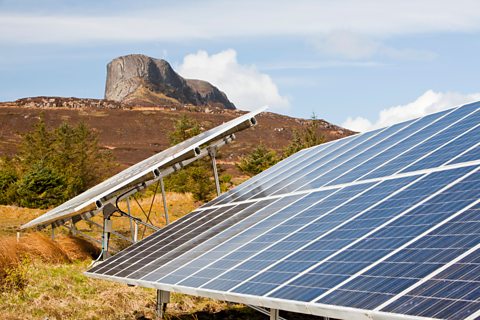Key facts
The electricity we use every day is the flow of negatively-charged particles called electrons.
Electricity is generated by converting a different form of energy into electrical energy.
This energy can come from renewable and non-renewable sources.
Most of our electricity is generated at power stations and transported to where it is needed via our National Grid of power lines and cables. Some of these cables have large pylons in fields. Others are underground and connected to homes and buildings.
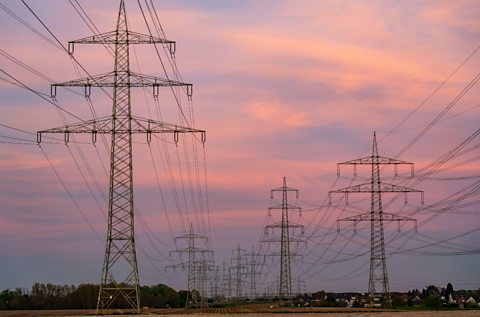
Generating electricity and its impacts
Find out about the different methods we can use to generate electricity.
Charging phones, turning the lights, on grabbing a snack from the fridge - they all use electricity. Electricity is the flow of tiny, negatively charged particles called electrons. All materials have electrons, but when the electrons in a material are free to move, it becomes a conductor.
For many years, most of the world has used non-renewable fuels to generate electricity. These non-renewables are fossil fuels such as coal, gas, and oil. When these fossil fuels are burned, they release heat energy. Heat energy is used to boil water and the steam it produces is then used to turn turbines. The heat energy is transferred to kinetic energy. The turbines are connected to generators. When the turbines turn, they turn large magnets which are surrounded by coils of wire. The movement of the magnets starts electrons flowing through the wires. It is this process that generates the electrical energy we need for our homes.
But, there are two major problems with generating electricity from fossil fuels. The first one is that when they're burned they release greenhouse gases into the atmosphere, such as carbon dioxide. These gases are a direct cause of climate change. The second problem is that these fuels will eventually run out, and when they're gone, they're gone. And this leads us nicely to renewables.
Wind farms, hydroelectric dams, wave farms are all renewable energies and they work in the same way as fossil fuel power stations. The use kinetic energy to turn turbines which turn generators. Solar cells and solar panels are also renewable, but they work differently. They use light from the sun to build up electric charges to start a current flowing more directly. Around fifty-five percent of the electricity Scotland generates comes from renewable energy sources. Mostly from wind farms and hydroelectric power stations.
The bad news is that, globally, over at eighty percent of the energy we generate still comes from non-renewables. What do you think? Count how many items you use in a day that need electricity, and try and find out if they're using a renewable source.
What is electricity?
We use electricity every day. Make a list of everything you did this morning before coming into school. Look at it again, how many of those things involve electricity?
Electricity is the flow of tiny, negatively-charged particles called electrons. Materials that allow electrons to flow through them are called conductors. Metals, such as copper that is used in electrical wires, are conductors of electricity.
Electricity is a form of energy. Energy can be converted or transferred from one form to another. We make electrical energy by converting a different form of energy into electrical energy.
How do we generate electricity?
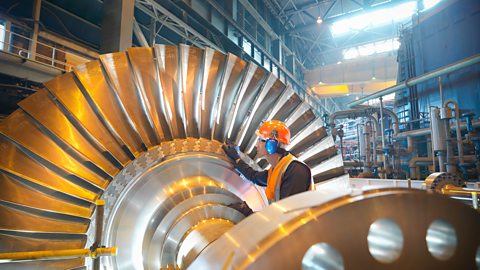
Most of the ways we generate electricity involve kinetic energy.
Kinetic energy is the energy of movement. Moving gases or liquids can be used to turn turbines:
Most renewable energy sources start with kinetic energy.
- Wind turbines are turned by moving air.
- Hydroelectric turbines are turned by water flowing down through pipes.
- Wave and tidal turbines are turned by the movement of the sea.
Non-renewable energy sources (Nuclear, biomass and fossil fuels) all start with chemical energy.

- Fossil fuels are burned releasing heat energy.
- Heat energy is used to boil water and the steam it produces is then used to turn turbines. In doing this, heat energy is transferred to kinetic energy.
- The turbines are connected to generators. When the turbines turn, they turn large magnets which are surrounded by coils of wire.
- The movement of the magnets starts electrons flowing through the wires and kinetic energy is transferred to electrical energy.
- It is this process that generates the electrical energy we need for our homes.
What is inside a generator?
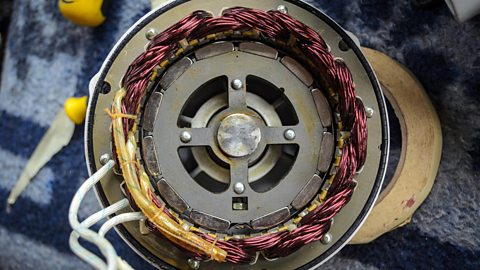
In power stations, turbines are connected to generators. Inside the generator is a ring of magnets and this is surrounded by another ring, made up of lots of tightly wrapped metal wire.
When the generator turns, the magnets spin round. The movement of magnets past the wires makes electricity start to flow through the wires.

How does solar power generate electricity?
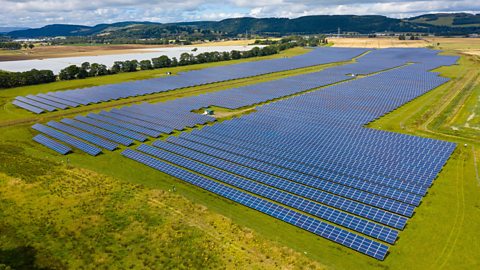
Unlike other energy sources, generating electricity from solar power does not use turbines. Solar cells transfer light energy from the Sun into electrical energy directly.
When sunlight hits layers of silicon inside solar cells, an electric charge builds up, creating a flow of electricity.
Because solar panels rely on sunlight, they only generate electricity during the daytime when sunlight is shining on them. If it is cloudy, they are less effective and if it is night time, they do not generate any electricity.
It is only the light energy from the sun that solar panels use.
The temperature does not change the amount of energy generated by a solar panel, so it doesn't matter if it is a hot or cold day, It is only the strength of sunlight that makes a difference.

Sustainability
To develop a sustainable future you need to think about meeting today's needs and protecting the environmentĚý˛ą˛Ô»ĺĚýresources for the future.
There are many different kinds of renewable sources and they generate electricity in different ways.
Wind farms, wave power, hydroelectric power, and geothermal energy can all be used to generate electricity. They all use the same idea to generate electricity. They convert kinetic energy into electrical energy using turbines and generators.
Solar cells use light from the sun to build up charges to start a current flowing.
While they all have the benefits and drawbacks, they are a cleaner way of generating electricity than fossil fuels.
Fossil fuel electricity generation
Advantages
- The infrastructure is already in place for generating electricity from fossil fuels.
Disadvantages
- Fossil fuels burn to produce carbon dioxide which is a greenhouse gas and contributes to climate change.
- Fossil fuels are non-renewable and will run out soon. We will not be able to rely on these forever!
Renewable sources to generate electricity
Advantages
- Renewable sources such as wind, solar, and waves, are sustainable and will not run out.
- Renewable sources are a cleaner way of generating electricity - they do not produce Greenhouse Gases.
- Set up costs for sources such as wind power are cheaper that other sources such as nuclear power
Disadvantages
- Some renewables - such as wind, waves, and solar - are not always available. Wind farms cannot generate electricity on windless days, and solar power doesn't work on cloudy days.
- There could be high costs to replace existing fossil fuel based electricity generating infrastructure with newer, renewable infrastructure.
- There are location factors. Hydroelectric power only works in locations with lots of water, for example.
More on Energy sources and sustainability
Find out more by working through a topic
- count5 of 12
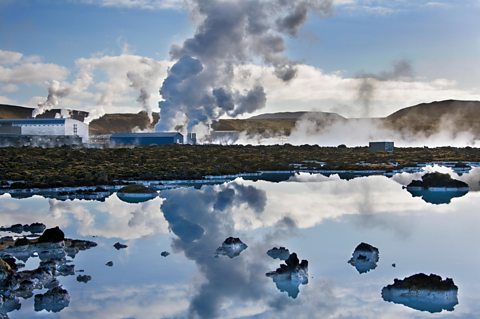
- count6 of 12
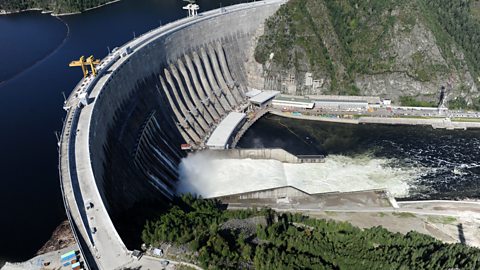
- count7 of 12

- count8 of 12
